Exploring the Twin Tip Kiteboard: A Detailed Examination
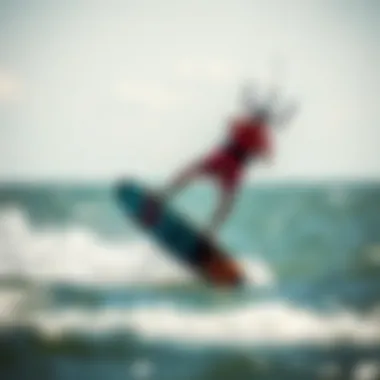
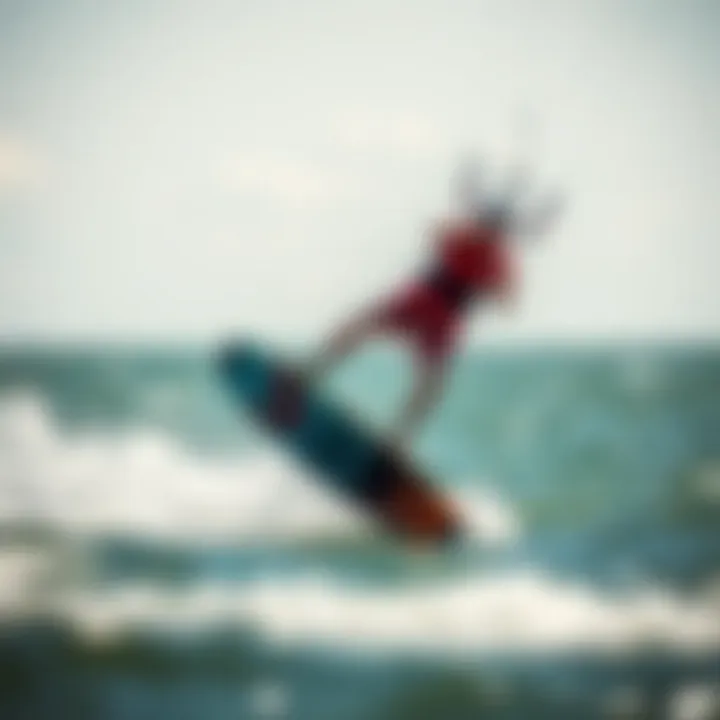
Intro
Kiteboarding has rapidly gained traction over the years, being recognized for its mix of excitement and freedom. Among the various types of equipment, twin tip kiteboards stand out due to their versatility and ease of use. This article takes a closer look at these boards, diving into their design and functionality. Knowing what to consider means you'll be better prepared to make an informed decision that aligns with your skill level and riding style.
As we delve deeper, we'll focus on key aspects such as the materials used in production, performance characteristics, and comparison with other kiteboard types. Each point will clarify why twin tips are an essential part of any kiteboarder's gear. Instead of being just another piece of equipment, these boards have their own unique characteristics, catering to various riders from novice to experienced.
Gear and Equipment
Essential Kiteboarding Gear for Beginners
For those taking their first steps into the kiteboarding arena, having the right equipment is critical. The following essentials make kiteboarding more accessible and enjoyable:
- Safety gear: A quality helmet and impact vest to minimize injuries.
- Kite: Beginners typically use larger kites, which can generate more lift yet are easier to control.
- Bar and Lines: Your control bar should be suited to your kite's size, keeping the lines tangle-free to ensure steady performance.
- Wetsuit: Depending on your local climate, a good wetsuit protects against cold water, enhancing comfort during your rides.
- Twin Tip Kiteboard: This is the centerpiece of your gear—opt for a lightweight board that is forgiving for beginners.
New kiteboarders often find that starting on a wider twin tip board gives them stability while they are learning how to ride.
Advanced Equipment for Experienced Riders
Once you've mastered the basics, it’s time to consider upgrading your gear. Experienced riders often look for performance and responsiveness in their equipment:
- High-Performance Kite: An advanced rider typically chooses a kite tailored to specific conditions and their riding style, such as wave or freestyle.
- Specialized Twin Tip Board: These boards focus on carving and handling, often featuring advanced technology for superior performance.
- Bindings: Adjustable bindings allow for comfort and flexibility, crucial when executing complex maneuvers.
- Foil Board: While not a twin tip, a foil board offers another dimension to exploration in kiteboarding, letting you ride above water.
Upgrading equipment allows for elevated performance and opens up new styles that can be immensely rewarding.
Techniques and Tips
Basic Riding Techniques for Newbies
Starting out can be challenging, but keeping a few simple techniques in mind can ease the learning curve:
- Stance: Keep your knees slightly bent and your weight centered over the board.
- Edge Control: Learn to edge the board properly against the water for better control and speed.
- Kite Positioning: Position the kite at around 45 degrees in the wind to maintain consistent lift.
- Balance: Use your hips for weight distribution; leaning back helps in gaining speed.
These basic skills create a strong foundation to build upon.
Expert Tricks to Elevate Your Skills
As you advance, you’ll likely want to incorporate expert tricks to impress fellow kiteboarders. Some tricks include:
- Jumping: Timing your jump with the kite’s pull can lead to simultaneously landing a stylish trick.
- Cutbacks: Executing quick turns will challenge your skills and allow for dynamic riding.
- Spin Tricks: Adding spins enhances your aerial maneuvers and makes your ride visually appealing.
- Grabs: A simple grab during a jump adds personal flair and can be a stepping stone to more complex tricks.
Practicing these techniques regularly will help sharpen your skills and enrich your kiteboarding experience.
Achieving mastery in kiteboarding is not about the gear you have but how well you understand and connect with it.
In summary, twin tip kiteboards offer exciting options for every level of rider. With the right gear, techniques, and a willingness to learn, anyone can thrive in this thrilling sport. Whether a beginner or an experienced rider, understanding your twin tip board and how to use it can lead to unforgettable experiences on the water.
For more in-depth information on kiteboarding and equipment, check resources from Wikipedia, Britannica, and the kiteboarding community on Reddit.
Preface to Twin Tip Kiteboarding
Twin tip kiteboarding is not just a hobby; it’s an experience that combines skill, technology, and the beauty of nature. This section sets the stage for understanding why these boards deserve attention, especially for anyone keen on kiteboarding or water sports. The twin tip design is popular from beginners to seasoned pros not just for its performance, but also for the versatility it offers.
One might wonder what sets twin tip boards apart from other board types. Generally, these boards are symmetrical, allowing riders to ride in either direction. This feature makes it easier for newcomers to pick up the sport and boosts confidence, leading them to try more maneuvers sooner rather than later. Apart from that convenience, twin tip boards are typically designed for specific styles, whether it’s freestyle, freeride, or wave riding. This range of applications is a significant draw; riders enjoy the freedom to experiment with different styles, which helps to keep the sport fresh and exciting.
Moreover, there’s no shortage of riders that have been captivated by the rush of cutting through the water with a twin tip beneath them. These boards have shown a remarkable rise in popularity over the years, aided by advancements in materials and construction techniques. With many brands competing to innovate and improve, one can expect enhanced performance attributes, safety features, and an overall focus on user experience. The depth of choice available means that every rider can find a board that matches their skill level, body type, and personal style.
Definition of Twin Tip Boards
A twin tip board is essentially a type of kiteboard that has a symmetrical design at both ends. Unlike directional boards, which are shaped to ride in one specific direction, twin tip boards allow for riding in either direction. This design is perfect for those who want the freedom to change directions without the hassle of turning around.
There are several characteristics that define a twin tip kiteboard. First is the flat bottom shape, which enhances the board’s ability to glide smoothly over the water’s surface. Additionally, twin tips often have a distinct rocker profile, which allows for easier manipulation during tricks and jumps. This feature also ensures that even if a rider lands awkwardly, the board can absorb some impact and keep them afloat.
In terms of size, twin tips can vary widely, with some designed for lighter riders and others built to accommodate heavier individuals. The relationship between board size and rider weight is crucial in achieving optimal performance. Additionally, pads and straps on twin tip boards provide added comfort and stability, making it far easier for riders to feel secure while riding.
Popularity Among Riders
Twin tip kiteboards have gained significant traction among a diverse group of water sports enthusiasts. The balance of usability and performance is a key factor. New riders find themselves drawn to these boards because they facilitate a quick learning curve, allowing them to feel the exhilaration of riding right away.
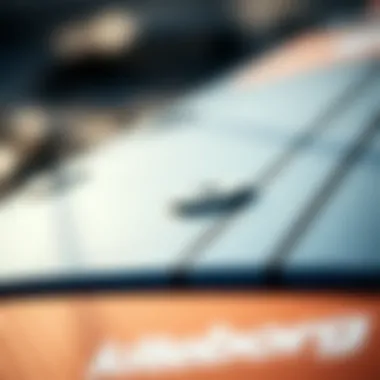

Not only are twin tips beginner-friendly, but they also appeal to experienced riders seeking to push their limits. They are often seen in freestyle competitions, where the board's design allows for high-flying tricks and sharp maneuvers. Riders find them popular because they are highly versatile: ideal for playful jumps, strapped or strapless riding, and even those big carves in the waves.
Moreover, the community surrounding twin tip kiteboarding has been a major part of its popularity. Various social media platforms and dedicated forums, such as Reddit, feature discussions and showcases of riders' stunts, which attract more people into the sport.
Many can relate stories of how they began on a twin tip and later moved on to more complex setups, yet always keep a twin tip in their quiver for those days when they simply want to have fun without worrying too much about technique. All these factors contribute to the strong following and enthusiastic community that has helped solidify the twin tip board's place in the kiteboarding world.
Historical Background
Understanding the historical background of twin tip kiteboarding is crucial for grasping how these boards transformed the sport and influenced rider experiences across the globe. The evolution of kiteboarding isn't just a story of gear; it's a narrative woven from innovation, lifestyle adaptations, and the ever-changing demands of water enthusiasts. Twin tip boards, in particular, have played a pivotal role in shaping the course of this exciting sport. They've become a staple for many riders, with their designs catering to both leisure surfers and high-performance athletes.
The Evolution of Kiteboarding
Kiteboarding traces its roots back several decades, with experiments dating back to the late 1970s. Initially, the sport used homemade gear with varying success. What started as a curious blend of surfing and kiting evolved, leading to the creation of various kite shapes and styles. Early on, designers relied heavily on primitive materials that didn't hold up against the demands of the sea and wind. As technology advanced, the introduction of modern synthetics and the refinement of kite shapes fundamentally changed the game.
During the late 1990s, the kiteboarding community witnessed the first significant leaps in board design. The twin tip board made its entrance at a point where riders were looking for versatility and performance enhancement. Unlike traditional directional boards, twin tips allow for seamless riding in both directions. This development opened the door for a broader array of tricks and maneuvers, which propelled the sport into a new competitive realm.
Prologue of Twin Tip Design
The introduction of the twin tip design was nothing short of revolutionary. This board's unique shape enabled riders to execute tricks that were previously thought to be too challenging or impossible. Riders could easily transition from heel to toe side without the hassle of turning the board around. The symmetrical design provides balance and increases control, making it particularly advantageous for jumping and surfing under various wind conditions.
Moreover, twin tip boards generally boast shorter lengths and wider widths, which further enhance stability and maneuverability. Riders often report that these boards feel lighter and more responsive than their directional counterparts. The design also fosters a more intimate connection with the water, giving riders the confidence to push their limits.
In the ever-changing landscape of kiteboarding, twin tip boards have established themselves as a universal choice. Popular among both novice and seasoned riders, they continue to adapt and improve as manufacturers invest in R&D, exploring new materials and cutting-edge designs to enhance performance and aesthetics. This continuous evolution ensures that every ride is just as exciting as the last, keeping the spirit of kiteboarding alive and thriving.
"The twin tip board has become an emblem of versatility, a testament to human ingenuity in pursuit of thrills on water."
With a solid understanding of the historical context of twin tip kiteboarding, riders can appreciate not only the boards themselves but also the cultural significance and community that surrounds them. The past sets the stage for the current innovations we see today, and as we explore the subsequent sections, one can only ponder what the future could hold for the next generation of kiteboard designs.
Understanding Design Elements
When delving into the intricacies of twin tip kiteboards, understanding design elements becomes a cornerstone of appreciating their functionality and performance. Each feature, from shape to materials and construction, contributes to how a board handles various riding styles and conditions. Knowing these elements can help riders make informed decisions while selecting equipment that aligns with their personal preferences. It’s a bit like assembling a jigsaw puzzle; each piece must fit seamlessly with others to create a cohesive experience on the water.
Shape and Outline
The shape and outline of a twin tip board are vital in defining how it performs. Generally, twin tip kiteboards feature a symmetric design which allows for easier direction changes without needing to switch stances. This characteristic proves particularly beneficial for beginners who are grappling with the basics; even if you’re trying to master those first tentative turns, the board’s design supports these efforts.
Key Considerations:
- Nose and Tail Design: A pointed nose can cut through water more efficiently, offering better performance in rougher conditions, while a rounded tail can provide an easy lift, ideal for jumps.
- Rockers: The board's rocker – the arch from nose to tail – impacts how it rides over waves and choppy waters. A flat rocker offers speed, whereas a pronounced rocker helps with maneuverability and tricks.
Overall, the shape not only influences your speed but also plays a critical role when you're out there catching those perfect waves or attempting that next big trick!
Performance Analysis
Performance analysis is a crucial element in understanding how twin tip kiteboards function in various scenarios. This section sheds light on the key performance attributes that set these boards apart, making them a choice pick among kiteboarding enthusiasts. Unlike other boards, twin tips are uniquely engineered to provide adaptability and control, which translates directly into an enhanced riding experience.
Stability in Various Conditions
When it comes to stability, twin tip kiteboards are specifically designed to maintain balance across different water conditions. Whether it’s choppy waters or glassy lakes, the shape and edges of these boards help gauge how they react to the environment. Riders appreciate that when wind kicks up, the board’s design keeps them upright, which can mean the difference between a smooth ride and an abrupt halt.
- For instance, a rider on the coast of California might encounter unpredictable waves, yet, with a well-designed twin tip board,
- Edge control becomes paramount, allowing for sharp turns.
- Upwind riding is more manageable, as the board's shape assists in fighting against the wind.
- Comfort during landings ensures that jumps remain exhilarating rather than energy-draining.
Stability is not just a matter of staying upright; it's about giving the rider confidence to push their limits.
Versatility for Different Styles
Versatility is where twin tip kiteboards truly shine. Given their design attributes, these boards provide a broad spectrum of riding styles, catering to everyone from novices to seasoned pros. With a twin tip, riders can easily transition from flat water cruising to tackling waves or even jumping.
Consider a rider who loves mixing it up. They might start their session performing small jumps on flat water, then move to a small surf break to practice their carving skills. A few reasons why versatility is a significant advantage include:
- Compatibility with various riding styles: Twin tips allow for free riding, freestyle, or even racing.
- User-friendly: Their symmetrical design means they can be ridden in either direction, making them accessible for learners while still offering challenges for the experts.
- Flexibility in tricks: Many advanced tricks, such as spins and flips, become easier with a twin tip, thanks to their balance and responsiveness.
User Experience Feedback
User feedback plays a pivotal role in analyzing performance. Riders continually share their experiences on forums and social media platforms, giving insights into how these boards handle real-world conditions. Many kiteboarders emphasize that the best performance indicators often come from anecdotal evidence, rather than solely from manufacturer specifications.
"Every time I hit the water, I feel like my twin tip board gets better as I do. Every trick or turn is an experience. It's as if the board intuitively understands my balance and responds accordingly."
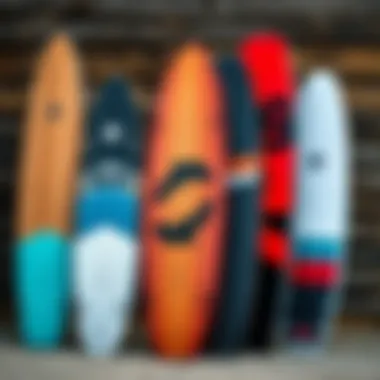
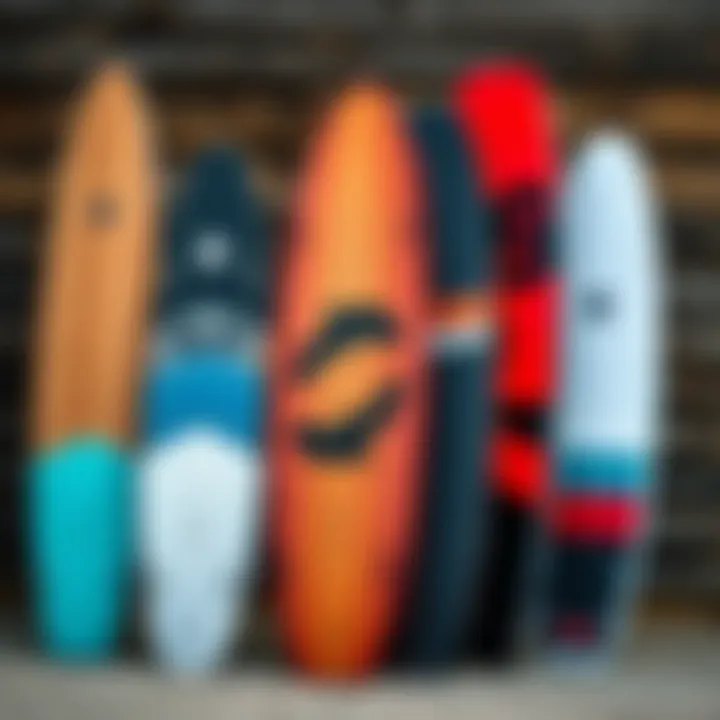
This kind of feedback helps newcomers and veterans alike find boards that resonate with their riding style. Plus, word-of-mouth often leads them to choose specific brands that have proven reliability and performance in their respective communities. Whether sharing videos of jumps on platforms like Reddit or posting experiences on Facebook groups, the feedback is invaluable.
In summary, performance analysis of twin tip kiteboards illuminates several key features: stability across various conditions, versatility for different riding styles, and the importance of user experiences. Understanding these elements not only elevates a rider's skills but also enhances the overall kiteboarding adventure.
Choosing the Right Twin Tip Kiteboard
Choosing the appropriate twin tip kiteboard is a crucial step for anyone stepping into this thrilling sport. Each kiteboard caters to a specific rider's needs, enhancing the enjoyment and effectiveness of your sessions on the water. Understanding the distinctive elements related to your skill level, size and weight, along with the riding conditions, can make all the difference in your kiteboarding experience. A well-tailored board does more than just float; it harmonizes with your style and enables you to unlock your potential.
Skill Level Considerations
When it comes to selecting a twin tip kiteboard, one's skill level is paramount. A beginner often benefits most from a board that offers stability and ease of maneuverability. A wider shape allows for a smoother ride, which can instill confidence. For instance, many novices might find boards like those from Cabrinha suitable as they prioritize user-friendliness. As riders progress, they tend to seek more advanced performance features, such as increased responsiveness and agility. Hence, intermediate riders might gravitate towards boards that offer a balance between stability and trick potential, like those from Duotone.
In contrast, seasoned kiteboarders who crave performance will look for boards that are much more specialized. These boards tend to be lighter and more responsive, designed to handle those daring tricks. It’s critical to recognize how far you’ve come and pick a board that complements your journey. Trying someone else's board in a similar skill bracket can help provide insights into what works best for you.
Board Size and Your Weight
The size of the twin tip kiteboard is fundamentally linked to a rider’s weight. Boards are generally categorized by length, and this becomes particularly relevant in determining how much lift and control a rider can expect. A heavier rider might need a larger board to ensure adequate buoyancy and stability, particularly in lighter winds. Conversely, lighter riders can often opt for shorter boards, which are typically more agile and easier to control during tricks.
Here are a few guidelines to follow regarding board size:
- Board length typically ranges from 130cm to 160cm.
- Heavier riders (over 180 lbs) are advised to choose boards around 140cm to 160cm.
- Lighter riders (under 150 lbs) might find boards from 130cm to 140cm to work best.
Checking the manufacturer's recommendations often helps. Consider boards made by North or Slingshot who provide detailed charts that match board size to rider weight. This careful consideration can enhance the overall riding experience.
Riding Conditions
The conditions under which a kiteboarder intends to ride can influence their selection significantly. Wind strength, water chop, and the type of environment—whether flat water or waves—should all factor into the decision. In areas with lighter winds, a larger board aids in getting up on the plane, performing well even when the gusts are modest. On the flip side, when tackling choppy or rough waters, a smaller board might be favored for its enhanced control and maneuverability.
Kiteboards designed specifically for wave riding typically feature a shape that holds up against strong currents and choppy waters, while those intended for freestyle often have a flatter outline for easy landings. Riders who venture into diverse locations might consider boards that adapt well across various conditions, allowing for a more versatile approach.
Ultimately, the effectiveness of a twin tip kiteboard hinges on the rider's needs and the specific conditions. Sifting through this sea of choices may seem daunting, but focusing on these pivotal aspects can simplify the selection process.
"The best kiteboard is the one that feels like an extension of yourself on the water."
Thus, making an informed choice regarding your twin tip kiteboard ensures that you not only enjoy your time riding but also progress smoothly on your kiteboarding journey.
Techniques for Mastering Twin Tip Kiteboarding
Mastering twin tip kiteboarding requires a blend of technical skills and an understanding of the nuances of the sport. It's not just about riding; it's about harnessing the wind and maneuvering with precision. Techniques for Mastering Twin Tip Kiteboarding provides insights that are essential for riders eager to elevate their proficiency on the water. With these techniques, one can unlock the full potential of the twin tip design and enhance the overall kiteboarding experience.
In this section, we’ll delve deeply into the basic maneuvers that every novice should learn, alongside advanced tricks and tips that can set an experienced rider apart.
Basic Maneuvers
Every successful kiteboarder must start from the ground up. Basic maneuvers are the building blocks of kiteboarding and play an essential role in developing good habits. Here are some key skills to focus on:
- Getting Up and Riding: Begin with the right body position. Start in the water on your knees; when you're ready, bring the kite to the 12 o’clock position. The key here is to pull on the back hand and shift your weight to your legs gradually. This will give you that sought-after lift.
- Changing Direction (Tacking): Practicing turns is vital. Start carving upwind by shifting your weight and using your edges to maintain speed. Then, put the kite slightly forward and lean back to initiate the turn smoothly. Keep your momentum and ride back to the other side, ensuring enough power in your kite.
- Stopping and Recovering: Learning how to stop abruptly can save you from a tumble. Lean back slightly and dig your heels into the water to slow down. When ready to come back, maintain a relaxed stance and let the kite carry you back.
These basic skills not only provide the foundation you need but also build confidence. After mastering these, transitioning to advanced techniques becomes much smoother.
Advanced Tricks and Tips
Once you’re comfortable with basic maneuvers, the world of advanced tricks opens up. These can not only impress onlookers but also enhance your riding experience significantly.
- Jumping: To jump, begin with speed. As you approach an ideal spot, pull hard on the back line while pushing down with your feet. The kite should be at the right angle to catch the wind, which will elevate you. The trick lies in controlling your landing by bending your knees.
- Spins: A basic but effective trick. To perform a spin, you must combine a jump with rotation. As you leave the water, look over your shoulder and shift your body weight to initiate the spin. Use your arms to guide your turn, landing safely back on the board.
- Handle Passes: This move takes some practice and coordination. Initiate a jump, then as you reach the apex, pass the handle behind your back while keeping your eyes on the board. Catching the handle again as you land smoothly requires good timing and skill.
"The only limits are those you set for yourself. With practice and perseverance, you can master even the most complex maneuvers."
Incorporating these advanced tricks can add another dimension to your riding. However, it’s crucial to practice them in safe environments and to be aware of your surroundings. Kiteboarding safety is paramount, so always check conditions and gear before attempting new techniques.
By mastering these essential techniques and progressing through the ranks, one can truly appreciate the thrill that comes with twin tip kiteboarding. Whether you're carving through waves or soaring above the water, each new skill adds to the rider's repertoire, enhancing both competence and enjoyment on the water.
Safety Considerations and Guidelines
Safety is an essential pillar of any adventure sport, and kiteboarding is no exception. Knowing the risks involved and having a solid understanding of safety precautions can mean the difference between a fun day at the beach and a potential disaster. In the context of twin tip kiteboarding, a sport known for its exhilarating experience, attention to safety considerations and guidelines takes center stage.
Understanding Kiteboarding Risks
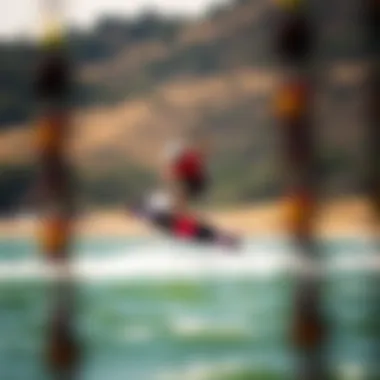
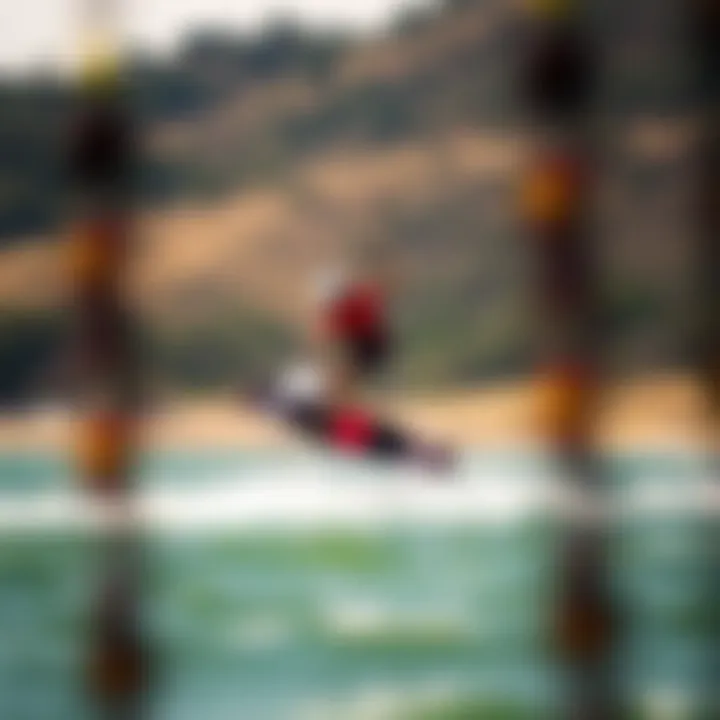
When you hit the water with a twin tip kiteboard, there's an adrenaline rush, but it’s vital not to lose sight of safety. Kiteboarding has several inherent risks, which include:
- Injury from Falls: The learning curve can be steep; beginners may fall frequently, leading to potential strains, sprains, or worse.
- Kite Control Issues: Loss of control over the kite can lead to collisions with obstacles or other riders, increasing the chances of injury.
- Environmental Hazards: Debris in the water, rough conditions, or unexpected changes in weather can pose threats.
- Drowning: Although rare, being knocked out or incapacitated in the water could lead to drowning if proper precautions aren't taken.
As someone who’s gearing up to ride, being aware of these risks is crucial. Acknowledging and understanding them allows you to make informed decisions on when and how to ride safely.
Preventative Measures
Being proactive is the name of the game in kiteboarding safety. Here are some critical preventative measures that every rider should consider:
- Wear the Right Gear: Invest in a proper life jacket and a helmet. These can offer protection if a fall occurs or if there’s a collision.
- Kiteboarding Lessons: If you’re new, don’t skimp on proper training. Lessons with a qualified instructor can equip you with safety knowledge and skills essential for riding safely.
- Check Equipment Regularly: Before every session, inspect your gear—lines, straps, and the kite itself. A quick check can prevent mishaps.
- Know the Environment: Familiarize yourself with local conditions. Make sure you're aware of current weather patterns and know how to read the wind. Always check for any restrictions at your riding spot.
- Practice Safety Signals: Develop hand signals with fellow riders for communication. This can help in alerting each other about any potential hazards without shouting over the wind.
- Stay within your Skill Level: Avoid pushing your limits too far too fast. Knowing your skill level helps in selecting the right conditions and spots for riding.
- Buddy System: Whenever possible, try to ride with a partner. Having someone else around can be invaluable in case of emergency.
Remember: In kiteboarding, safety isn’t just a suggestion; it’s a critical part of the experience.
By keeping these safety measures in mind, you can enjoy the thrill of twin tip kiteboarding while minimizing risks. It all boils down to staying aware, staying prepared, and most importantly, having fun while being smart about it!
Comparative Analysis of Kiteboard Types
Understanding the landscape of kiteboarding involves delving into the different types of boards available. This comparative analysis offers crucial insights for riders, helping them make informed choices tailored to their preferences and riding conditions. The discussion will illuminate the defining features of twin tip boards in relation to other types, specifically directional and hybrid boards. This is not just a matter of preference; it’s about grasping how these differences affect performance, versatility, and overall enjoyment of the sport.
Twin Tip vs. Directional Boards
When comparing twin tip boards to directional ones, the most notable difference lies in their design and functionality. Twin tip boards, as the name implies, can be ridden both forwards and backwards, which provides an unparalleled level of versatility. This design encourages a freer style of riding; whether one is executing jumps or carving turns, a twin tip board is often the go-to option.
On the flip side, directional boards are ideally suited for those who focus on surfing-style maneuvers on the waves. They are built to glide effectively downwind and usually favor a more traditional stance. While directional boards excel in wave riding and provide a unique experience when managing larger swells, they are less forgiving in terms of versatility. Riders are typically limited to one direction, which can necessitate more technical skill when it comes to turning.
Here are a few distinctions to consider:
- Riding Style: Twin tips are more adaptable, perfect for freestyle tricks, whereas directional boards shine in wave conditions.
- Skill Level: Beginners often find twin tips easier to navigate, yet those with experience may appreciate the challenge that directional boards offer.
- Surface Compatibility: Twin tips perform better in flat water, while directional boards are optimized for ocean swells.
Hybrid Board Options
As kiteboarding enthusiasts seek the best possible experience, hybrid boards have emerged as an exciting alternative. These boards blend the attributes of both twin tip and directional designs, delivering a unique experience that caters to various riding styles.
Hybrid boards tend to feature a shape that enables multifaceted riding—allowing smooth transitions from flat water to small waves. For those who love experimenting with different techniques, hybrids often deliver a balance between speed and maneuverability, making them suitable for a range of riders.
Considerations when exploring hybrid boards include:
- Versatility: They handle diverse conditions effectively, adapting to different styles of riding.
- Performance Flexibility: Providing a good compromise, these boards are especially popular among those who enjoy both freeriding and wave riding.
- Target Audience: Ideal for intermediate to advanced riders who want to push their limits while still enjoying some comfort in varying conditions.
Environmental Considerations in Kiteboarding
Understanding the environmental impact of kiteboarding is vital for the sport’s sustainability. As outdoor enthusiasts, kiteboarders must consider the footprint that this activity leaves on natural terrains. The problem isn’t just about enjoying the thrill of the wind and water; it’s about ensuring that these natural resources last for generations to come. Here, we’ll look into specific aspects that affect our environment and the benefits of mindful practices in kiteboarding.
Impact of Materials on the Environment
In kiteboarding, the materials used in equipment manufacture can have a significant impact on the environment. Traditional kiteboarding gear often includes materials like PVC and other non-biodegradable substances. These materials can take hundreds of years to decompose, leading to polluted beaches and waterways.
- Non-biodegradable Materials: Many kiteboards, especially older models, utilize composites that aren't friendly to our planet. For instance, glass and carbon fibers are common, but they don't break down.
- Production Waste: The manufacturing process can generate a considerable amount of waste. Factories that produce kiteboards might not employ the cleanest methods, which can lead to harmful emissions and other pollutants.
To add, ensuring the use of eco-friendly materials is crucial. Modern boards now come equipped with biodegradable or recyclable components like bio-resin and flax fiber, which are less harmful to the environment. By opting for gear made of sustainable materials, kiteboarders can minimize their environmental footprint while still enjoying their passion.
Sustainable Practices
Fostering sustainability in kiteboarding doesn’t only rely on the materials used but also on the practices of the users. Here are a few sustainable practices every kiteboarder can adopt:
- Equipment Care and Repair: Instead of frequently purchasing new gear, taking care of your equipment prolongs its life. Repairing rather than replacing can save resources and reduce waste.
- Responsible Use of Land and Water: Stick to designated kiteboarding spots to minimize impact on natural habitats. Avoid nesting sites or environmentally sensitive areas.
- Participating in Clean-Up Initiatives: Many kiteboarding communities organize beach clean-ups. Engaging in these efforts can help maintain picturesque locations for future adventures.
"Protecting our oceans and coastlines isn’t just a responsibility. It’s a commitment to future generations who will also seek the thrill of kiteboarding."
Adopting these practices enhances not only the environmental scene but also contributes to a healthier community and a more sustainable kiteboarding experience. The collective choice lays the groundwork to safeguard the gorgeous coastlines and windy shores we cherish.
Closure
The discussion of twin tip kiteboards comes to a satisfying conclusion with a firm understanding of their design, performance, and applications. This article has dove deeper into the nuances that define twin tip boards and their significance in the kiteboarding community, highlighting how these boards cater to a diverse range of riders, from beginners to seasoned experts.
In terms of key takeaways, we've unraveled the distinct attributes that make twin tip kiteboards unique. They are praised not only for their impressive versatility but also their stability across varying riding conditions. With their innovative designs that include the shape and material selection, these boards are tailored for a myriad of styles, ensuring that each rider finds their perfect fit.
Moreover, the importance of selecting the right twin tip kiteboard lies in understanding one's own skill level, weight considerations, and prevailing riding conditions. These decisions can significantly enhance the riding experience. Being well-informed about board options can save riders not just money but also frustration, enabling them to hit the waves with confidence and ease.
Additionally, as the environment increasingly becomes a focal point in recreational sports, the commitment from manufacturers towards sustainable practices reflects a wider trend that aligns with modern consumer values. It's worth noting that by choosing eco-friendly options, enthusiasts are not just investing in their skill but also in the health of our planet.
Future prospects for twin tip kiteboarding seem bright. Continued advancements in material technology and design promise even greater performance enhancements. Whether through innovations in board construction, or embracing sustainable manufacturing methods, the journey ahead is one of exciting developments. Riders can look forward to boards that are lighter, stronger, and even more efficient.
From an overall perspective, the exploration of twin tip kiteboarding not only enriches the understanding for current enthusiasts but opens doors for new participants as well. As kiting only grows in popularity, the twin tip design stands at the helm of these changes, perfectly blending enjoyment with practical riding dynamics.















